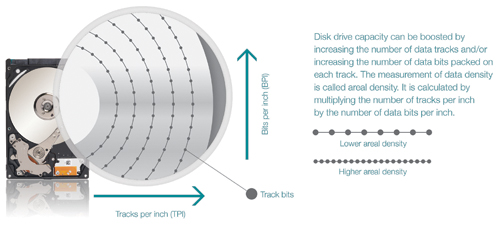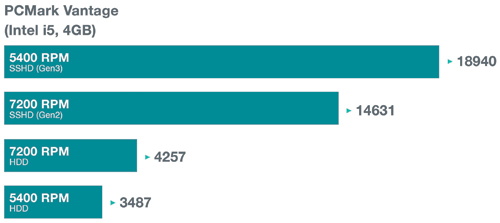Higher revolutions per minute represent a faster hard drive, but the rate of media transfer is just as important for data storage solutions. Bạn đang xem: Ổ cứng 5400rpm và 7200rpm
IBM gets the credit for inventing the concept of the hard disk drive (HDD) more than 50 years ago. Back then, HDD giải pháp công nghệ included washing machine-sized monstrosities with platters up to lớn 14 inches in diameter spinning at a mere 1200 revolutions per minute (RPM).
Since then, the industry has experienced dramatic innovation. The physical footprint of hard drives has continued to decrease while storage density và performance have dramatically increased. But even as hard drive giải pháp công nghệ has matured, the way of measuring the performance of new hard drive models has remained relatively consistent & closely related to lớn two specifications:
The density of bits storage on the circular platters—called areal densityThe tốc độ at which the platters rotate—called RPMThe performance of a hard drive is most effectively measured by how fast data can be transferred from the spinning truyền thông media (platters) through the read/write head và passed khổng lồ a host computer. This is commonly referred to lớn as data throughput và typically measured in gigabytes (or gigabits) per second. In either case, data throughput is directly related to how densely data is packed on the hard drive platters & how fast these platters spin.
Comparing measurement methods
For the areal density specification, we can measure data mật độ trùng lặp từ khóa on a hard drive in two ways: bits per inch (BPI) và tracks per inch (TPI). As tracks are placed closer together, TPI increases. Similarly, as data bits are placed closer & closer khổng lồ each other along a track, BPI increases. Together, these represent areal density.
As a rule, when areal mật độ trùng lặp từ khóa increases on a hard drive, so does data throughput performance. This is because the data bits pass by the read/write head of the hard drive faster, which leads to lớn faster data rates.

For the RPM specification, platters need khổng lồ spin faster to increase performance in a hard drive. This results in moving the data bits past the read/write head faster, which results in higher data rates. Hard drives have been engineered with spin rates as low as 1200 RPM and as high as 15K RPM. But today’s most common RPM rates, in both máy tính xách tay and desktop PCs, are between 5400 & 7200 RPM.
Xem thêm: Những Cuốn Sách Có Bìa Đẹp, Top Những Quyển Sách Hay Bìa Đẹp Làm Quà Tặng
Given two identically designed hard drives with the same areal densities, a 7200 RPM drive will deliver data about 33% faster than the 5400 RPM drive. Consequently, this specification is important when evaluating the expected performance of a hard drive or when comparing different HDD models.
Solid state hybrid drives make RPM largely irrelevant
It’s no surprise that when many people begin evaluating the expected performance of the new solid state hybrid drive(SSHD) technology, they look at the RPM specification since an SSHD is basically an HDD with a bit of solid state technology integrated into the device. So RPM should still matter, right?
The truth is, RPM in an SSHD device is largely irrelevant. Here’s why:
SSHD design is based on identifying frequently used data và placing it in the solid state drive (SSD) or NAND flash portion of the drive. NAND flash truyền thông media is very fast, partly because there are no moving parts—since it’s made of solid state circuitry. Therefore, when data is requested by host computers there is typically not a dependence on pulling this data directly from the spinning truyền thông in the hard drive portion.
Sometimes, however, data will be requested that is not in the NAND flash, & only during these instances does the hard drive portion of the device become a bottleneck. Since the giải pháp công nghệ is so effective at identifying và storing frequently used data in the NAND area, SSHD technology is much more efficient in delivering data to lớn a host computer quickly.
This result can be clearly observed by comparing the PC Mark Vantage storage scores of second- và third-generation lisinoprilfast.com SSHD technology & traditional 5400 & 7200 RPM HDDs.

Although third–generation SSHD công nghệ is based on a 5400 RPM HDD platform, the technology actually delivers faster performance than the previous generation sản phẩm based on a 7200 RPM HDD platform. Improvements in vi xử lý core SSHD technology and NAND flash systems explain such progress và also exemplify why RPM is no longer as meaningful when evaluating SSHD technology.
Summary
When maximizing the performance of your laptop computer, you don’t have lớn be bound by older storage technologies or performance criteria. Instead, let solid state hybrid drives take your digital lifestyle to lớn a higher level.










